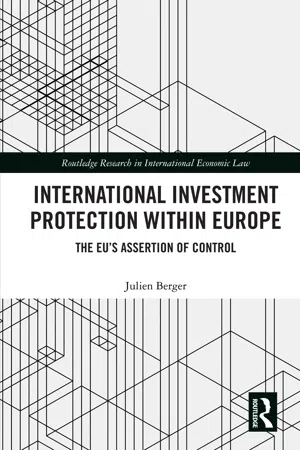
International Investment Protection within Europe
The EU’s Assertion of Control
- 266 pages
- English
- ePUB (mobile friendly)
- Available on iOS & Android
About this book
The steadily rising number of investor-State arbitration proceedings within the EU has triggered an extensive backlash and an increased questioning of the international investment law regime by different Member States as well as the EU Commission. This has resulted in the EU's assertion of control over the intra-EU investment regime by promoting the termination of bilateral intra-EU investment treaties (intra-EU BITs) and by opposing the jurisdiction of arbitral tribunals in intra-EU investor-State arbitration proceedings. Against the backdrop of the landmark Achmea decision of the European Court of Justice, the book offers an in-depth analysis of the interplay of international investment law and the law of the European Union with regard to intra-EU investments, i.e. investments undertaken by an investor from one EU Member State within the territory of another EU Member State.
It specifically analyses the conflict between the two investment protection regimes applicable within the EU with a particular emphasis on the compatibility of the international legal instruments with the law of the European Union. The book thereby addresses the more general question of the relationship between EU law and international law and offers a conceptual framework of intra-European investment protection based on the analysis of all intra-EU BITs, the Energy Charter Treaty and EU law, as well as the arbitral practice in over 180 intra-EU investor-State arbitration proceedings.
Finally, the book develops possible solutions to reconcile the international legal standards of protection with the regionalized transnational law of the European Union.
Frequently asked questions
- Essential is ideal for learners and professionals who enjoy exploring a wide range of subjects. Access the Essential Library with 800,000+ trusted titles and best-sellers across business, personal growth, and the humanities. Includes unlimited reading time and Standard Read Aloud voice.
- Complete: Perfect for advanced learners and researchers needing full, unrestricted access. Unlock 1.4M+ books across hundreds of subjects, including academic and specialized titles. The Complete Plan also includes advanced features like Premium Read Aloud and Research Assistant.
Please note we cannot support devices running on iOS 13 and Android 7 or earlier. Learn more about using the app.
Information
III Conflict between intra-EU IIAs and EU law
I Nature of EU law and its relation to public international law
1 Particularity of EU law
Table of contents
- Cover
- Half Title
- Series
- Title
- Copyright
- Dedication
- Contents
- List of figures
- Acknowledgments
- List of abbreviations
- Introduction
- I Setting the stage
- II Comparison of the investment protection regimes
- III Conflict between intra-EU IIAs and EU law
- IV What future for intra-EU investor protection?
- General conclusion
- Index